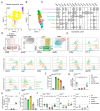This is a preprint.
Thymic DC2 are heterogenous and include a novel population of transitional dendritic cells
- PMID: 40666966
- PMCID: PMC12262426
- DOI: 10.1101/2025.06.13.659520
Thymic DC2 are heterogenous and include a novel population of transitional dendritic cells
Abstract
Myeloid cells, including dendritic cells (DCs) and macrophages, are essential for establishing central tolerance in the thymus by promoting T cell clonal deletion and regulatory T cell (Treg) generation. Previous studies suggest that the thymic DC pool consists of plasmacytoid DC (pDC), XCR1+ DC1 and SIRPα+ DC2. Yet the precise origin, development, and homeostasis, particularly of DC2, remain unresolved. Using single-cell transcriptomics and lineage-defining mouse models we identify nine major populations of thymic myeloid cells and describe their lineage identities. What was previously considered to be "DC2" is actually composed of 4 distinct cell lineages. Amongst these are monocyte-derived DCs (moDC) and monocyte derived macrophages (moMac), which are dependent on thymic interferon to upregulate MHCII and CD11c. We further demonstrate that conventional DC2 undergo intrathymic maturation through CD40 signaling. Finally, amongst "DC2" we identify a novel thymic population of CX3CR1+ transitional DC (tDC), which represent transendothelial DCs positioned near thymic microvessels. Together, these finding reveal the thymus as a niche for diverse, developmentally distinct myeloid cells and elucidate their specific requirements for development and maturation.
Conflict of interest statement
J.I. reported personal fees from Immunitas Therapeutics outside the submitted work. The other authors declare no competing interests.
Figures





References
-
- Akiyama T., Shimo Y., Yanai H., Qin J., Ohshima D., Maruyama Y., Asaumi Y., Kitazawa J., Takayanagi H., Penninger J.M., Matsumoto M., Nitta T., Takahama Y., and Inoue J.-I.. 2008. The tumor necrosis factor family receptors RANK and CD40 cooperatively establish the thymic medullary microenvironment and self-tolerance. Immunity. 29:423–437. doi: 10.1016/j.immuni.2008.06.015. - DOI - PubMed
-
- Alcántara-Hernández M., Leylek R., Wagar L.E., Engleman E.G., Keler T., Marinkovich M.P., Davis M.M., Nolan G.P., and Idoyaga J.. 2017. High-Dimensional Phenotypic Mapping of Human Dendritic Cells Reveals Interindividual Variation and Tissue Specialization. Immunity. 47:1037–1050.e6. doi: 10.1016/j.immuni.2017.11.001. - DOI - PMC - PubMed
-
- Ardouin L., Luche H., Chelbi R., Carpentier S., Shawket A., Montanana Sanchis F., Santa Maria C., Grenot P., Alexandre Y., Grégoire C., Fries A., Vu Manh T.-P., Tamoutounour S., Crozat K., Tomasello E., Jorquera A., Fossum E., Bogen B., Azukizawa H., Bajenoff M., Henri S., Dalod M., and Malissen B.. 2016. Broad and Largely Concordant Molecular Changes Characterize Tolerogenic and Immunogenic Dendritic Cell Maturation in Thymus and Periphery. Immunity. 45:305–318. doi: 10.1016/j.immuni.2016.07.019. - DOI - PubMed
-
- Ashby K.M., Vobořil M., Salgado O.C., Lee S.T., Martinez R.J., O’Connor C.H., Breed E.R., Xuan S., Roll C.R., Bachigari S., Heiland H., Stetson D.B., Kotenko S.V., and Hogquist K.A.. 2024. Sterile production of interferons in the thymus affects T cell repertoire selection. Sci Immunol. 9:eadp1139. doi: 10.1126/sciimmunol.adp1139. - DOI - PMC - PubMed
Publication types
Grants and funding
LinkOut - more resources
Full Text Sources
Research Materials
